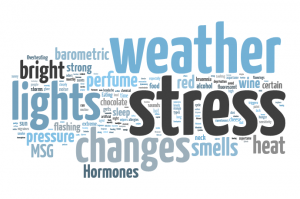The Myths Behind Migraines
A migraine headache is a severe unilateral and pulsating discomfort that is associated with extreme sensitivity to light, sound, smell, taste, and touch that generally lasts between 4 and 72 hours. According to Daniela Pietrobon and Jord Striessnig in “Neurobiology of Migraine,” migraines affect 6-8% of men and 15-25% of women in western countries. At least 1% of the population has a minimum of one day of migraine per week – which means around 2.5 million people in North America are sufferers. In fact, migraines are currently ranked as one of the most disabling chronic disorders. With such a high prevalence, it may seem peculiar how little is known about this condition. However, with the help of recent experimental studies, we are beginning to advance our understanding of the physiological and biological factors that contribute to triggering a migraine. Unfortunately, due to the lack of knowledge about this disease, there are many myths associated with it. I shall address some of these myths in the hope of broadening the general understanding of both the disease and its sufferers.
Myth 1: Migraines are simply bad headaches exaggerated by the sufferer.
Truth: Unfortunately, this is a common creed adopted by a vast majority of both the general public and many physicians. For the past century, there has been negative stigma placed on migraine sufferers. Society has long placed the blame of migraines on migraineurs, believing that their migraines are nothing more than headaches that are exaggerated by their sufferers and caused by stress. This is false. According to M.A.G.N.U.M., the National Migraine Association, “migraine is a disease, a headache is only a symptom.” A migraine sufferer can experience “nausea, vomiting, auras (light spots), sensitivity to light[, scent,] and sound, numbness, difficulty in speech, and severe semihemispherical head pain.” In addition, it is important to note that the cause of migraine pain has been found to be the opposite of the cause of most non-migranous headaches. Migraine pain is generally caused by the dilation of blood vessels in the brain, while other typical headaches appear to result from vasoconstriction. Further, migraines have been found to be genetically linked, where an individual has a 50% chance of suffering from migraines if one of his or her parents is a migraineur.
Myth 2: Migraines are caused solely by psychological factors.
Truth: While stress, depression, and anxiety can all worsen the symptoms of a migraine, they are rarely the sole cause. According to M.A.G.N.U.M., “migraine is a neurological disease, not a psychological disorder.” A migraine is a result of vasodilation in the cranial blood vessels, resulting in an overstimulation of the nerve synapses. Furthermore, migraines can be triggered by both controllable and uncontrollable factors. Controllable stimulants can include bright lights, loud noises, strong scents, and various foods (notably those that are aged or nitrate-latent). Uncontrollable triggers can include hormone changes and weather variations, including fluctuations in barometric pressure, temperature, and humidity. One can often lessen the risk of incidence of a migraine attack by reducing the controllable triggers. However, this is not always enough to fully prevent a migraine spell.
Myth 3: Any doctor should be able to effectively recognize and properly treat migraines.
Truth: Although members of the medical community are generally highly knowledgeable in their fields, migraines still remain one of the most misdiagnosed and mistreated diseases today. This is primarily due to the inherent lack of knowledge about and overall awareness of migraines and their symptoms. M.A.G.N.U.M. goes on to say that, “In fact, 60% of women and 70% of men with migraines have never been diagnosed with this disease.” These migraine sufferers are often misdiagnosed with clinical depression and/or other psychological disorders, leading doctors to mistreat them with various prescription drugs. Hopefully, as our understanding of this disease grows, we can educate both the medical community and the general public about migraines, in an attempt to vastly increase correct diagnoses and treatments.
According to Dr. Silberstein, M.D., F.A.C.P., Co-Director, The Comprehensive Headache Center at Germantown Hospital and Medical Center, in a letter to M.A.G.N.U.M., “Migraine sufferers must not only cope with their pain, but also with society’s misunderstanding of the disorder.” Therefore, both knowledge and education are paramount in the fight of ridding the stigmas surrounding this disease.
– Alexa Aaronson
Sources:
Migraines: Myth Vs. Reality
<http://www.migraines.org/myth/mythreal.htm>
Migraines and Headaches: Overview & Facts
<http://www.webmd.com/migraines-headaches/guide/migraines-headaches-overview>
Neurobiology of Migraine
<http://physiology.elte.hu/gyakorlat/cikkek/Neurobiology%20of%20migraine.pdf>


January 6, 2016
NICE INFORMATION.
February 18, 2016
useful information
December 2, 2016
Nice Information
December 31, 2016
Hello! I would wish to supply a large thumbs up for your excellent info you could have here about this post.